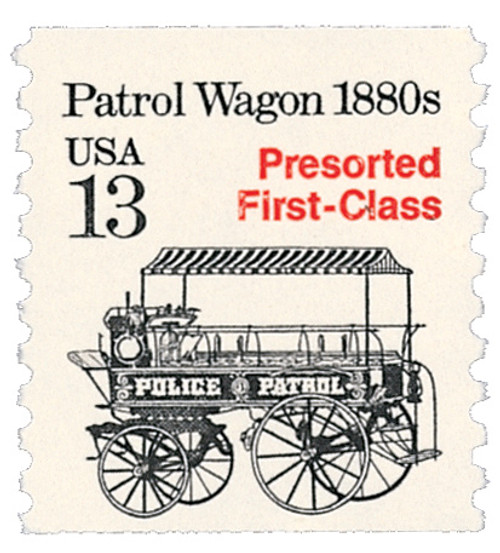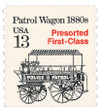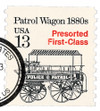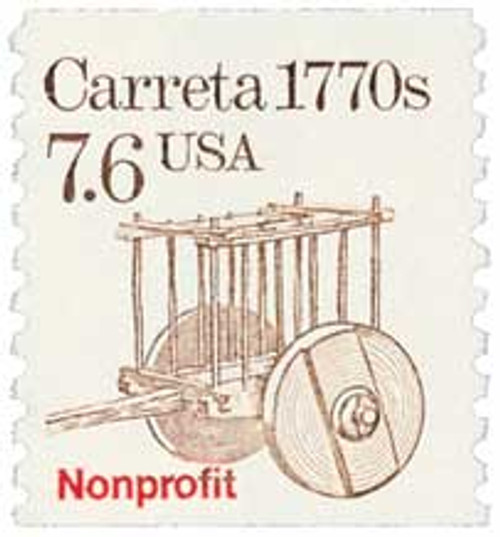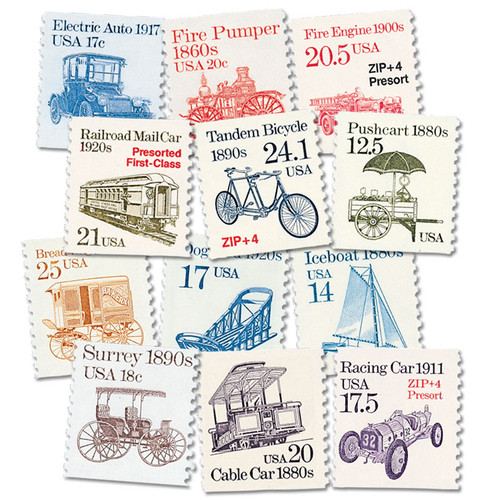
# 2258 - 1988 13c Transportation Series: Patrol Wagon, 1880s
U.S. #2258
1988 13¢ Patrol Wagon, 1880s
Transportation Series
- Pictures an original 19th century engraving of a police patrol wagon
- Precanceled for presorted first-class postcards
Stamp Category: Definitive
Series: Transportation
Value: 13¢, rate for presorted first-class postcards
First Day of Issue: October 29, 1988
First Day City: Anaheim, California
Quantity Issued: 63,133,000
Printed by: Bureau of Engraving and Printing
Printing Method: Engraved
Format: Coils of 500 and 3,000
Perforations: 10 vertical
Color: Black
Why the stamp was issued: To replace the 1985 12¢ Stanley Steamer stamp, paying the rate for presorted first-class postcards. The subject had been suggested the year before in a poll of Linn’s Stamp News readers.
About the stamp design: The USPS didn’t hire an artist to create the artwork for this stamp. Instead, USPS project manager Joe Brockert used an original engraving from the Berkebile dictionary. That image had been taken from The Carriage Monthly, Volume 21, 1885-86, illustration number 50.
Special design details: This stamp has a “Presorted First-Class” precancel. Precancels are stamps canceled before being sold, to make mailing faster and cheaper for customers with large amounts of mail. Bulk mailers use precancels, then pre-sort their mail and save money.
First Day City: The First Day ceremony for this stamp was held at the Disneyland Hotel in Anaheim, California during the annual convention of the American First Day Cover Society. Local police chiefs and officers received special invitations to attend the ceremony.
About the Transportation Series: On May 18, 1981, the USPS issued the first stamp in the Transportation Series, US #1907, picturing the Surrey, a doorless four-wheeled carriage. For the first time in US history, a coil stamp featured its own unique design rather than simply copying that of the current definitive stamp. Over 50 more coil stamps would be issued over the course of the next 15 years, each picturing a different mode of transportation. All of these types of transportation were used since American independence.
The various denominations provided face values to exactly match the rates for several categories of Third-Class mail (bulk rate and quantity-discounted mail). As the rates changed, new stamps with new values were added. Never before had a stamp series included so many fractional cent values.
The Bureau of Engraving and Printing printed most of the stamps in the Transportation Series, although private contractors printed a few. All but a few of the later stamps were produced by engraved intaglio. Differences in precancels, tagging, paper and gum provide a large number of varieties.
Scott Catalog separates the Transportation stamps into four groups. The stamps in the first group (#1897-1908) generally have the denomination in small type with a “c” next to it. These stamps were printed on the Cottrell rotary press, which joined together two plates to make a sleeve. The gaps between these plates created depressions where ink would collect and create joint lines on the stamps. Later issues were printed on a different press and didn’t have these joint lines.
The second group (#2123-36) had larger numbers with no “c.” The third group (#2252-66) was similar in appearance to the second group, but service inscriptions were added to the designs. These stamps also used a variety of paper and gum as well as different types of tagging. The fourth group (#2451-68) marked the end of fractional values. Now bulk mailers would use either the 5¢ or 10¢ stamp and then pay the difference from the actual postage rate.
The last stamp in the Transportation Series, the 20¢ Cog Railway, was issued on June 9, 1995, at the TEXPEX ’95 stamp show in Dallas, Texas. This marked the end of the largest US definitive series up to that time. Three new series would eventually replace it – American Transportation, American Culture, and American Scenes. Additionally, the Great Americans would go on to become the largest American definitive series.
History the stamp represents: Introduced in Chicago in 1879, the police wagon was part of a plan to get policemen where they were needed as soon as possible. This canopied, horse-drawn wagon was used to transport police to the scene of the crime and escort prisoners to jail.
U.S. #2258
1988 13¢ Patrol Wagon, 1880s
Transportation Series
- Pictures an original 19th century engraving of a police patrol wagon
- Precanceled for presorted first-class postcards
Stamp Category: Definitive
Series: Transportation
Value: 13¢, rate for presorted first-class postcards
First Day of Issue: October 29, 1988
First Day City: Anaheim, California
Quantity Issued: 63,133,000
Printed by: Bureau of Engraving and Printing
Printing Method: Engraved
Format: Coils of 500 and 3,000
Perforations: 10 vertical
Color: Black
Why the stamp was issued: To replace the 1985 12¢ Stanley Steamer stamp, paying the rate for presorted first-class postcards. The subject had been suggested the year before in a poll of Linn’s Stamp News readers.
About the stamp design: The USPS didn’t hire an artist to create the artwork for this stamp. Instead, USPS project manager Joe Brockert used an original engraving from the Berkebile dictionary. That image had been taken from The Carriage Monthly, Volume 21, 1885-86, illustration number 50.
Special design details: This stamp has a “Presorted First-Class” precancel. Precancels are stamps canceled before being sold, to make mailing faster and cheaper for customers with large amounts of mail. Bulk mailers use precancels, then pre-sort their mail and save money.
First Day City: The First Day ceremony for this stamp was held at the Disneyland Hotel in Anaheim, California during the annual convention of the American First Day Cover Society. Local police chiefs and officers received special invitations to attend the ceremony.
About the Transportation Series: On May 18, 1981, the USPS issued the first stamp in the Transportation Series, US #1907, picturing the Surrey, a doorless four-wheeled carriage. For the first time in US history, a coil stamp featured its own unique design rather than simply copying that of the current definitive stamp. Over 50 more coil stamps would be issued over the course of the next 15 years, each picturing a different mode of transportation. All of these types of transportation were used since American independence.
The various denominations provided face values to exactly match the rates for several categories of Third-Class mail (bulk rate and quantity-discounted mail). As the rates changed, new stamps with new values were added. Never before had a stamp series included so many fractional cent values.
The Bureau of Engraving and Printing printed most of the stamps in the Transportation Series, although private contractors printed a few. All but a few of the later stamps were produced by engraved intaglio. Differences in precancels, tagging, paper and gum provide a large number of varieties.
Scott Catalog separates the Transportation stamps into four groups. The stamps in the first group (#1897-1908) generally have the denomination in small type with a “c” next to it. These stamps were printed on the Cottrell rotary press, which joined together two plates to make a sleeve. The gaps between these plates created depressions where ink would collect and create joint lines on the stamps. Later issues were printed on a different press and didn’t have these joint lines.
The second group (#2123-36) had larger numbers with no “c.” The third group (#2252-66) was similar in appearance to the second group, but service inscriptions were added to the designs. These stamps also used a variety of paper and gum as well as different types of tagging. The fourth group (#2451-68) marked the end of fractional values. Now bulk mailers would use either the 5¢ or 10¢ stamp and then pay the difference from the actual postage rate.
The last stamp in the Transportation Series, the 20¢ Cog Railway, was issued on June 9, 1995, at the TEXPEX ’95 stamp show in Dallas, Texas. This marked the end of the largest US definitive series up to that time. Three new series would eventually replace it – American Transportation, American Culture, and American Scenes. Additionally, the Great Americans would go on to become the largest American definitive series.
History the stamp represents: Introduced in Chicago in 1879, the police wagon was part of a plan to get policemen where they were needed as soon as possible. This canopied, horse-drawn wagon was used to transport police to the scene of the crime and escort prisoners to jail.

